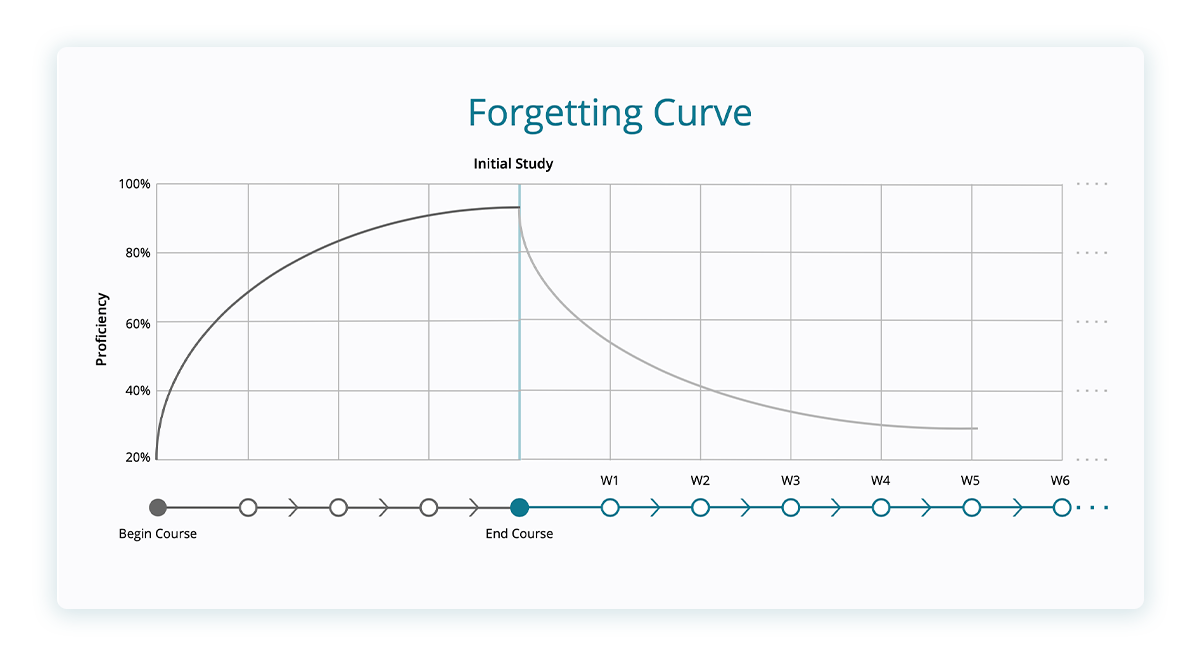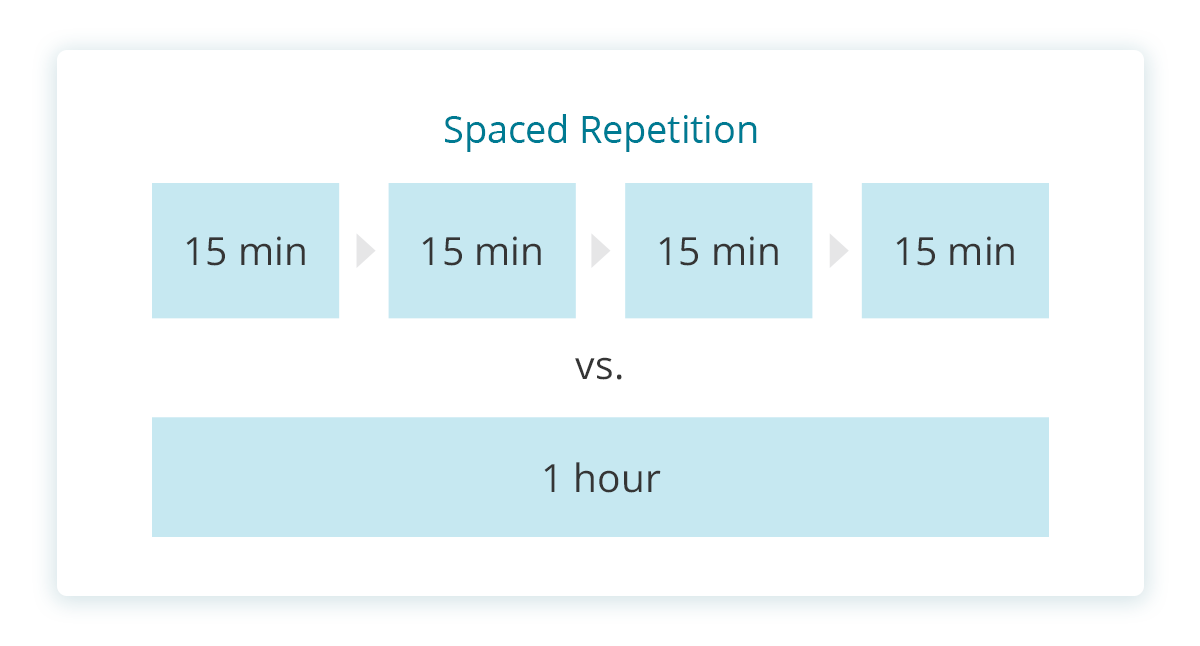3 Ways to Enhance the Microlearning in Your Digital Certification Training Program
Microlearning is the cornerstone of a successful digital certification training program. But how does it work? And how can you implement it today?
Balancing work and family life with continuing education efforts isn’t always easy. Many working professionals simply don’t have the spare hours to go through long in-person lectures or continuing education seminars.
A Georgia Tech Professional Education (GTPE) survey found that 80% of learners struggle to balance their certification training with their home-life obligations, job, and demanding schedules.
Digital certification training and exam prep providers must be empathetic to the busy lives of working professionals to ensure successful outcomes.
Microlearning is proven to boost learner confidence and build subject mastery, so training program providers can deliver more value to candidates than traditional learning modalities by leveraging microlearning strategies.
In this blog post, you will learn actionable ways to enhance the microlearning opportunities you already have in your certification training programs to take them to the next level and lead your learners to success.
What is Microlearning?
Microlearning is the practice of breaking large lessons into smaller, more manageable portions. Bite-sized content is a more efficient way to learn something new and the concepts are sweeping the education industry.
The roots of microlearning can be traced back to The Economics of Human Resources by Hector Correa (1963). However, modern microlearning didn’t truly take off until the mid-1990s with the advent of the internet—and even then, it was still relatively primitive compared to our modern technological capabilities.
While eLearning brought microlearning into the mainstream, smartphones and other mobile devices propelled the concept into the 21st century. Now microlearning can be leveraged to learn, study, prepare, and review certification training modules anywhere, at any time, and on any device.
With microlearning, content is delivered in focused, bite-sized chunks allowing learners to absorb and retain information bit by bit, rather than dumping large amounts of information on them at one time.
Microlearning Benefits
Mircolearning fosters learner engagement, improves subject mastery, and is accessible anytime, anywhere.
Keeps Learners Engaged
We naturally remember things we find entertaining and appealing. Using microlearning opportunities within several multimedia platforms will provide variety. Through infographics, podcasts, videos, PDFs, and games, learners can cover the same material through various mediums, thus boosting retention and engagement.
Two to ten-minute lessons spanning video-based learning, games, storytelling, and infographics are more engaging than traditional lectures.
Ideally, microlearning modules keep learners focused in a world full of constant distractions. Like a good story, your modules need to pique learners' interest and hold their attention, making them want to continue the lesson.
Improves Subject Matter Retention
Information that isn’t retained cannot be considered learned.
Lessons might be jam-packed with accurate and helpful information, but what purpose do they serve if learners don’t remember them? At its core, microlearning aims to boost learner retention through short-form modules and space learning.
Typically, each microlearning module gets more challenging than the last, building on previous information to explain the current lesson.
Starting from the bottom—the easy stuff—and working your way up is the best way to reinforce previous lessons and their relation to more complex concepts. This is called scaffolding, the progressive presentation of information.
Short-form content helps learners better understand the topic. Because of the brevity, you simply don’t have room for filler. Only the most essential concepts make it into the final lesson.
Think about your day-to-day life and how you absorb information. Most of it comes in short bursts. And while you probably have a few long-form mediums you enjoy (books, films, podcasts), you tend to remember these smaller morsels of knowledge with speedier recall.
Accessible Anytime, Anywhere
Finally, microlearning incorporates mobile technologies that modern learners are already accustomed to, such as their phones and tablets.
A study from the Rapid Learning Institute found that 94% of millennials prefer short-form modules (under 10 minutes) from the comfort of their phone.
Short lessons are accessible on the go, on a learner's own time. They may not have time to sit through an hour-long session in the morning. Instead, a few ten-minute microlearning modules after lunch might serve them better. Cramming these lessons ultimately defeats the purpose, which is why microlearning and spaced repetition go hand in hand.
Microlearning Effectiveness
Microlearning hinges on Ebbinghaus's forgetting curve, which proves that retention degrades over time.
People typically forget 80% of what they learned within one month without proper reinforcement.
Microlearning circumvents the curve by allowing learners to revisit short-burst modules during their everyday workflow. They can also leverage practice tests and exercises to reinforce those lessons.
To be most effective, microlearning must:
- Integrate with everyday life
- Engage learners
- Leverage date-backed and proven brain science
- Adapt on a learner-by-learner basis to offer personalized experiences

If your lessons meet the above criteria, you’ll be on your way to providing some of the best certification training on the market. To further enhance the microlearning for your certification training program, consider implementing these three strategies:
1. Use Gamified Microlearning to Increase Learner Engagement
One of the best ways to keep your learners engaged is through gamification because engaged learners retain more information.
Mixing games and competition into your microlearning modules helps counter learners' short attention spans. Learners stay more involved with the material when they can earn points or beat levels within modules. In the end, learning becomes more engaging and enjoyable for all parties.
The gamified microlearning trend is here to stay. This eLearning strategy helps you achieve your learning objectives in the most engaging way possible. How can you incorporate it into your training programs?
- Incorporate levels that learners progress through en route to their end goal/exam
- Provide games and challenges to complete within those levels
- Allow your learners to earn badges
- Display scores to measure success while providing instant feedback
- Track leaderboards to foster friendly competition and add a social element to the eLearning experience
Games make eLearning more fun and engaging; they also improve overall learner experience and retention levels. Thus, it stands to reason that microlearning and gamification are a match made in digital heaven. Combining them boosts:
Engagement
Games will spark curiosity among your learners, as they want to know how you’ve incorporated game-based mechanics into your certification training program. Meanwhile, microlearning helps them absorb and retain the information needed to complete different levels. Overall, the whole experience is more entertaining—and thus also more engaging.
Retention
Goal-oriented microlearning tackles objectives one at a time. Now, learners can focus on mastering each module before they move on to the next. And because that module is more engaging—thanks to gamification—you can expect a significant increase in learner retention.

Motivation
The best learners are motivated learners, and nothing drives motivation quite like healthy competition. Gamified microlearning modules can pit learners against themselves or each other with scores, timers, and leaderboards. While they’re having fun trying to beat their own score, they’re also retaining pertinent information—perhaps without even realizing it!
Processing Speed
Modern learners have short attention spans. However, the constant action of a game easily captures a learner's attention for more than the usual five minutes, allowing the necessary information to sink in.
But do adults really want to play games? According to extensive research, the overwhelming answer is yes! One study found that 90% of adults believe a fun work environment is more motivating, while another found that gamification improved engagement by 48%. Replace “work environment” with “learning environment,” and you’re looking at a virtual classroom full of motivated adults ready to tackle their microlearning modules.
Feedback
Video games are a fantastic source of instant feedback. Think of the last game you played and all the user feedback you received regarding how well you performed on a given level. How many collectibles did you find? How much health did you have left after the boss fight? Could you outperform yourself (or your peers) if you played the level again?
This kind of feedback ties into confidence-based learning, suggesting learners need a diagnostic test, followed by practice, and then another chance to ace the test before moving on to the next lesson. Incorporate gamification into your microlearning objectives to see drastic boosts in learner engagement and retention.
2. Leverage Spaced Learning in Conjunction with Microlearning in Practice Tests
Practice tests are the most crucial elements of digital certification training. Before your learners head into their final exam, practice tests offer them a chance to see where they stand and what information they might need to review.
While practice tests are essential, they don’t necessarily fit neatly within the context of your microlearning strategy. Traditional practice tests can take upwards of two hours, making them difficult to incorporate into daily life.
Your microlearning objectives can instead leverage short-form practice tests or exercises to prepare learners for a longer mock exam. They’ll build confidence as they complete these mini-tests, proving they’ve retained the information necessary to pass the final.
Practice exercises help identify your strengths and weaknesses when preparing for professional certification. We tend to focus on our accomplishments while ignoring our shortcomings. Learners must kick this habit—the only way to improve is by identifying and working on your weaknesses. Practice exercises provide instant feedback, telling you which areas could benefit from the additional review.
Practice exercises are also an excellent way to familiarize yourself with the final exam. Ideally, they use similar software and question types: fill-in-the-blank, multiple choice, short answer, or essay questions. Imagine a football player running plays at practice. If they simulate an actual game setting (offense vs. defense), they’ll have an easier time transitioning from the practice field to the stadium. However, spacing these practice exercises is just as important as taking them.
Spaced Repetition Reinforces Content
Spaced repetition feeds the brain. Your lessons teach and test the same information several times over a given period. The variety of mediums then gives the brain several angles on the same information. The more often the brain sees the same thing, the longer it holds onto that information.

Spaced repetition is as crucial with practice tests as with the lessons themselves. But how long should those intervals be? Well, the answer is different for everyone. One of the best spacing practices is to delay until you’re on the brink of forgetting the material. Then, go back and review it.
Spacing also depends on the certification and how long it’ll take to study. Some courses take six weeks—others might last six months to a year. Ensure you provide your learners with planned study guidelines based on the certification. For a more regimented day-to-day schedule, they can consider reviewing material:
- Right after the session (after taking a short break)
- Later that day or the next morning
- Three days later or at the end of the week
- To reinforce every few weeks
With a spaced repetition schedule in place, learners can leverage microlearning best practices to take supplementary practice tests, such as:
- Mobile access to practice exercises and modules
- Single-concept lessons (trimmed of “fat” or excess/unnecessary information)
- Relevant visuals for reference, reinforcement, and feedback
- Customized learning and test-taking environments
Providing learners with a well-populated question bank allows them to build practice exercises based on their weaknesses. They can choose how many questions they want to study, what topics to cover, and what types of questions and content they wish to see.
Your certification program admins can also curate exams if learners desire a little more direction. These may include 10 bite-sized exercises that take 15 minutes each. From there, they could recommend that learners do daily practice exercises for 10 days.
Spaced practice also depends on how much time learners have to complete their certification training. Busy professionals need more time, perhaps only completing their practice exercises once per week. On the other hand, learners with more flexible schedules could take short practice tests every few days—if not daily. Ultimately, one’s continued education schedule should be personalized to their unique situation.
3. Use Microlearning as the Building Blocks For Your Mobile Certification Training
Many on-the-go professionals prefer to carry phones and tablets instead of laptops. Similarly, most learners prefer using their phones as their primary content source. Put those two data points together, and you realize that your microlearning initiatives must meet learners where they are—on their mobile devices.
Crafting a 100% mobile experience is essential to your certification training program. Mobile Learning (mLearning) programs allow learners to tackle lessons on their own time, wherever they have an internet connection.

Modern Learner Characteristics
A modern learner is not a specific age or demographic. Most modern learners encompass one or more of the following traits:
- Impatient. They’re used to instant information and gratification from a simple Google search. Their preferred content is personal, relevant, and of high quality. Modern learners will rarely give you a second chance if your content lacks in one of those three categories.
- Easily distracted. Everything outside your lessons is trying to steal the modern learner’s attention. Think of all the notifications, alerts, and emails they get every minute of every day. Your training programs must keep them engaged, or they'll close the app and open their social media pages.
- Curious. It may seem like modern learners don’t care, but they’re actually hungry for knowledge. They just aren’t willing to sit through boring, hours-long lessons to get it. Impatience doesn’t hinder curiosity—but it will filter anything that doesn’t come quickly enough.
- Social. We’ve never been more connected than we are now. Modern learners are social creatures; they crave interaction, idea-sharing, and feedback from the community.
In fact, one study found that 73% of modern learners process information more efficiently when they share it.
With these traits in mind, it’s clear why mLearning programs driven by microlearning strategies are the most effective way to reach modern learners where they are. They’ll be able to learn on familiar devices in comfortable, self-controlled settings. They’ll be free from (most) distractions and can engage with others in their learning community.
How to Incorporate Mobile Learning Techniques
- Borrow from the mobile pros. When building your mobile program, steal as much as you can from the titans of attention-holding mobile apps—social media. Most people use their phones with one hand, using their thumb to click on navigation buttons. Make sure they can easily pinch, press, or zoom their screens without losing functionality.
- Leverage audio and video. Websites like YouTube and Vimeo make it easy to upload and share informational videos. Learners who prefer visual engagement will retain more information from watching a video than from listening to a lecture or reading an article. Podcasts and other audio-heavy mediums are crucial for on-the-go learners. They can easily pop in their earbuds and listen to a microlearning lesson while on a jog, at the gym, on the bus, or eating their lunch.
- Design for small screens. In the design phase, build your program with mobile habits in mind. Long screens with fewer clicks are better than multiple screens with several clicks. You must also consider the “fast scroller” who’ll inevitably scan text-heavy sections. Make sure the most important pieces of information stand out.
Incorporate Microlearning with BenchPrep
Adult learners looking to achieve digital certifications will boost their retention through microlearning lessons with spaced repetition. And while retaining that knowledge is crucial on exam day, the lessons learned must carry them throughout their careers.
Whether they’re studying for their real estate license, a law Bar exam, or other career certification—learners will flock to exam prep providers who can engage them through microlearning. Providing engaging, bite-sized content to boost retention and learner confidence is the future of eLearning. Of course, implementing microlearning strategies is no easy feat.
In order to achieve this feat, leading education and training companies can rely on the BenchPrep platform to use spaced repetition and microlearning to enhance their digital certification training program. After all, the two are often considered "two peas in a pod" because of how nicely they work together.
Want to learn more about how spaced repetition and microlearning go hand-in-hand, and how they can help learners achieve mastery in your learning program? Check out the blog below!






